Brief
“The typical pictures of poverty mask the fact that the very poor represent resilient entrepreneurs and value-conscious consumers.” —C. K. Prahalad
Pioneer firms that introduce an agricultural innovation face a number of challenges that can impede both the rate and the scale of adoption.
A challenging customer segment. Smallholder farmers have low purchasing power often linked to crop or livestock cycles. As a result, pioneer firms find it difficult to acquire a critical mass of early adopters who have both the inclination to consider an innovation and the disposable income to pay for it. Even when there are farmers willing to try the innovation, most do so in increments, hedging against failure by testing the innovation on only part of their land. They watch how it performs over a full crop or breeding cycle before fully adopting it, creating a time lag before a significant share of spending has been amassed among even the earliest adopters.
Pockets of applicability. The advantages conferred by agricultural innovations are highly dependent on ecological conditions. In contrast, the benefits of solar lights or clean cook stoves are manifested quickly and, by and large, consistently. Microfinance has been successful because of the applicability of credit for the poor: Affordable, timely credit (at 30% annual interest) provides a huge advantage over a local moneylender (at 120% annual interest) or over having no access at all to capital. In contrast, an agricultural product or service will perform differently in different environments. Finding these pockets of applicability takes time as a company comes to understand the impact of ecological conditions on performance.
Disconnected markets. Even when a new product is well adapted to local conditions, its spread across wide areas can be complicated by farmers’ geographic dispersion and by varying levels of infrastructure—both roads and forms of communication—in rural areas. Often, the quality of agricultural storage and processing and the access to agri-inputs, extension services, financing and markets vary from village to village and region to region. All of these influence the benefits to a farmer from a given product or service. Innovation adoption will likely be slower in areas recovering from recent political conflicts—areas that have experienced significant dislocations, broken family hierarchies and decimated productive capacity.
Immature business models. Given the small number of sizable, successful pioneer firms working with smallholder farmers, there is a dearth of proven models for founders to emulate. These new businesses often lack the strategies, processes, talent, systems and metrics to efficiently and effectively manage the growth of their firms. Growing a pioneer firm requires a series of iterations of its business model that make a company’s journey to scale anything but linear. As Vijay Mahajan, founder and CEO of the BASIX group of companies in India, says, “As you grow and learn as an organization, you move up and down the curve, you loop back and forth, and jump from one place to another as you figure out what works.”
It is because of these challenges that the Four A’s serve as a powerful unifying framework for addressing target customers’ needs. To understand the successes and challenges of addressing these structural barriers to adoption of innovations by smallholder farmers, we looked across the case-study companies to understand how each “A” has been addressed and to pinpoint what worked, what didn’t and why.

As in any other business context, the maxim “know thy customer” lies at the heart of promoting the adoption of agricultural innovations. No matter how game changing an innovation may be, entrepreneurs leading pioneer firms must have a deep understanding of, and commitment to, smallholder farmers to encourage the sustained adoption of their product or service. Through a relentless process of trial and error, leading pioneer firms have identified ways to persuade farmers to purchase their innovations season after season, despite variability in rainfall and other conditions. Understanding the importance of creating lasting bonds of trust with their customers, entrepreneurs become closer to smallholder farmers through direct and continuous contact. The most successful entrepreneurs understand not only how farmers live and work but also what they value, hope for and fear.
Entrepreneurs who invest time in achieving a nuanced understanding of smallholder farmers will reap significant rewards: The Four A’s will be transformed from obstacles to drivers of adoption.
Why farmers adopt: The Four A’s of adoption
Awareness
Before farmers adopt or test an innovation, they need to know about it and be motivated to test it on their land. How new customers learn about a product or service necessarily evolves as a firm grows. As illustrated by our primary research, early awareness is commonly generated by the company through its marketing efforts in farmer communities. As a product or service gains traction, farmer-to-farmer interactions become more potent sources of awareness. Firms become more effective as they grow by maintaining a strong presence in communities and systematically harnessing the power of loyal customers, who become the best advocates for the company.
Strategically target early adopters to maximize the “demonstration effect” and observability. To identify the archetype of a successful early adopter, a firm needs to determine both the environmental and farmer characteristics that best align with the product or service the firm is selling. Farmers with higher levels of income and social status, prior experience adopting innovations and access to media are generally more receptive to adopting new products or services.1 However, pioneer firms should look beyond demographic factors to target their best early-adopting customers. For example, GEWP determined that its microdrip irrigation system would be most effective for commercial crops like tomatoes, pomegranates and cotton, cultivated on a flat plot of less than five acres and having access to a well, so they targeted customers with these characteristics as their earliest adopters (see Figure 8).
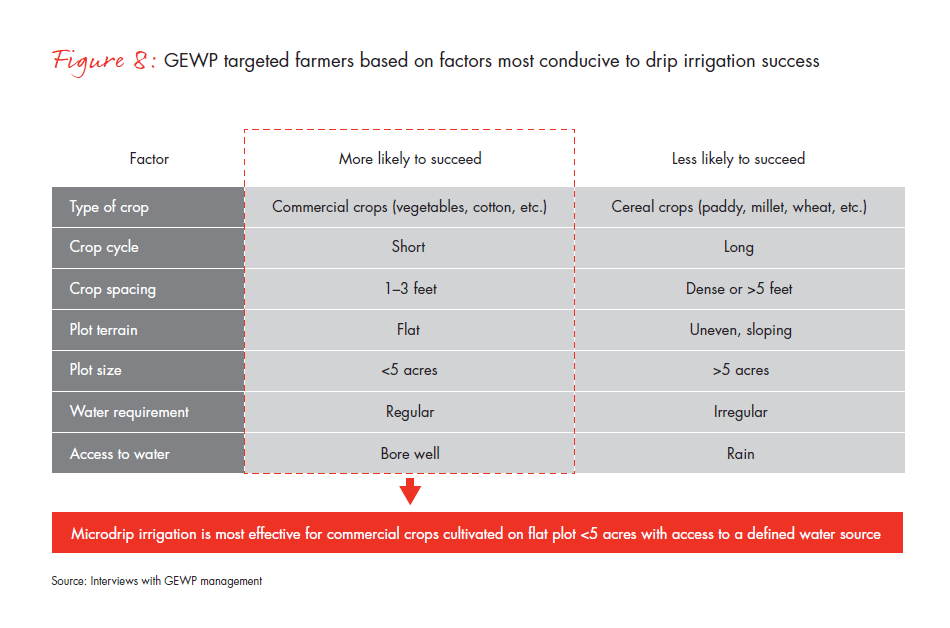
Similarly, Juhudi Kilimo uses a well-defined self-selection process to target farmers who are most likely to succeed in using asset-backed loans to increase productivity and income. The customers have to own their land (to reduce the likelihood of leaving the community without having repaid the loan), be willing to work in groups and attend weekly meetings and be able to save 15% of the loan amount. In addition to these process screens, the Juhudi Kilimo staff looks for farmers who are already interested in borrowing to purchase a productive asset (usually a cow) and who demonstrate the ability to manage that asset to make it productive. Collectively, these considerations provide a clear indication of a farmer’s inherent motivation and self-discipline. They also allow the company to assess the farmer’s level of commitment and loan repayment ability.
Finally, pioneer firms need to focus their awareness efforts on farmers whose success will have the greatest “demonstration effect.” They need to ask the question: Will this farmer’s successful use of the innovation be readily observable by his or her neighbors and spur broader adoption? As one farmer told us, “I will not risk using a new product for my crop before I can observe its benefits on someone else’s fields.” When piloting its microdrip irrigation system, GEWP selected farmers with vegetable plots (which have shorter cycles) located next to roads so that other farmers could readily observe the system’s performance. In northern Uganda, GADC made sure that its demonstration plots for organic cotton were near churches where farmers would gather every Sunday for services. Demonstration plots are especially valuable for firms whose salesforce will not be continuously present in a particular community for an extended time. In effect, readily observable benefits do some of the work of persuading the broader community to adopt.
Ensure success of early adopters through dissemination of technical knowledge. The advantage conferred by a new product or service is often realized only if farmers have specific, detailed guidance on how to use it. A farmer may not necessarily know, for example, that a new seed must be planted after three consecutive days of rainfall, in rows 6 inches deep and 18 inches apart. If the company doesn’t build this type of education and reinforcement into its sales process, early adopters will not experience the advantage that the innovation offers.
Widely disseminate success stories tailored to target customers. Early adopters’ success stories are the most powerful tool to spur broader adoption by other farmers. A well-designed market activation strategy applies tailored outreach methods that range from village-level demonstrations to broadcast media. For example, Juhudi Kilimo purchases time for radio broadcasts on local stations to raise awareness of success stories. During hour-long broadcasts, a Juhudi Kilimo business development officer interviews a customer who is local or from a nearby region and who has significantly benefited from Juhudi Kilimo’s services. Similarly, GEWP used many different methods, from painting billboards to showing Bollywood- style films, to explain the virtues of using microdrip irrigation.
Amplify word-of-mouth effect by leveraging customer advocates (“promoters”). Bain’s research has established a strong link between customer advocacy and profitable, sustained growth.2 As pioneer firms seek to drive adoption across a broader, dispersed base of customers, they should use “promoters”—customers who recommend that their friends and relatives purchase a product—as an important, cost-effective resource. Juhudi Kilimo determined that word-of-mouth referrals by friends and relatives were by far the most common way farmers heard about its lending services. In fact, according to Juhudi Kilimo’s CEO, Nat Robinson, up to 60% of its customers come through referrals (the proportion was even higher in our survey sample of Juhudi Kilimo customers). To actively promote referrals, the firm requires its existing customers to bring five other farmers with them when they attend training sessions.
Sustain brand presence to maintain and enhance customer relationships and trust. Pioneer firms that fail to maintain “share of voice” over time run the risk of losing their existing customers, capturing a smaller share of new customers or both. This can mean that a successful first mover loses market leadership as competitive offerings enter the market, especially for products or services with low barriers to entry. GEWP experienced just this. After an initial flurry of marketing activity, the company’s salesforce did not revisit many communities on a regular basis. As a result, farmers were more likely to switch to another provider or stop using the product altogether.
There is an understandable split between product and service companies in this regard. Product companies often spend a lot of time initially in communities to build demand but, like GEWP, may then move on to new areas. Conversely, service companies often need to maintain a continual presence in a community, as their models are built around regular customer interactions on a prolonged basis. NRSP and Juhudi Kilimo’s microfinance model includes weekly or monthly meetings with customers for collections. As a Juhudi Kilimo business development officer explained: “Given distrust of microfinance institutions, we must maintain our presence and support farmers continuously in group meetings and training sessions. This effort also helps to build our brand.” Eighty percent of the firm’s customers we interviewed said they were satisfied with their level of interaction with company personnel. “Juhudi officers meet with me twice a month to provide training on animal husbandry and check on the group’s progress. They are here whenever I need them,” one farmer told us.
Successful product companies have ongoing marketing activities and periodic village visits to check in with customers and understand how well the product is working. This post-sales support and sustained customer interaction help build trust by showing farmers the company is invested in the long-term success of the community. This trust is a significant brand asset and becomes increasingly important as competitors’ alternative offerings become available to the customer.
Awareness: Key questions to ask
- To what extent do farmers know about your product or service category (e.g., microfinance, microdrip irrigation) and about your specific company offering?
- Which customers are most likely to be early adopters of your product or service innovation? What characteristics (e.g., demographic, behavioral, environmental) should guide your sales team’s early-adopter customer targeting efforts?
- Is the accompanying information (e.g., planting techniques, installation) critical to your product’s effective use always shared and well understood?
- What are the most effective communication channels to reach your target customers?
- How will you identify the “promoters” among your early-adopter customers and empower them to tell other prospective customers about your product or service?
- How will you sustain your presence in the communities in which you operate over time?
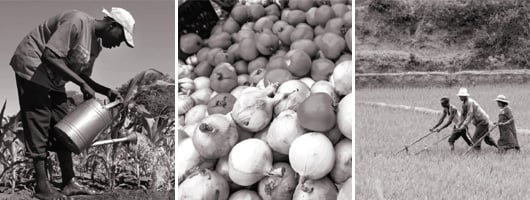
Advantage
As discussed in Chapter 2, advantage is the most important of the Four A’s for adoption: A farmer needs to perceive and experience the benefits provided by a new product or service to consider adopting it on a paid, sustained basis. Pioneer firms must concentrate their efforts on understanding farmers’ unmet needs and identifying solutions to provide significant advantage.
Maximize advantage through a deep understanding of target customers’ needs. GEWP started with a very clear understanding of the farmers’ unmet needs. Across India, farmers largely rely on the monsoon to provide sufficient water for their crops. Even if farmers are lucky enough to have access to a well, they need to ensure the well has sufficient water at the right time of year. They also need to have sufficient money to purchase diesel fuel for generators that pump the water to their fields. Farmers often simply flood their fields to ensure plants receive water, wasting precious resources and encouraging the growth of weeds, which must be removed, usually by hand. Drip irrigation uses less water, and as the water falls directly on or very close to the specific plant stalk, significantly fewer weeds grow. However, drip irrigation was initially out of reach for the smallholder farmer. It was too costly and sold in packages better suited to larger, multiple-acre farms.
GEWP’s drip irrigation kits address these problems. It should be noted that GEWP did not try to create a product for all farmers. The firm created a product that was well suited for smallholder farmers in Maharashtra, growing crops such as vegetables and fruit trees, for which drip irrigation works well. Furthermore, GEWP acknowledged that the product would work best on flat land, given that increased water pressure is required to move water up hills. Finally, the product was designed to be used on a plot as small as one-quarter of an acre and robust enough to be moved and stored when not being used—important because many smallholder farmers own multiple small plots and rotate crops, some of which may not be suited for drip irrigation. Depending on crop type and local soil conditions, GEWP management has seen the use of KB Drip increase productivity by 20% to 90%. Reduced water consumption lowers irrigation costs because less money needs to be spent on diesel fuel to power a pump. Minimizing weeds further reduces costs, as does the reduced need for fertilizer, which can be delivered directly to the crop via irrigation pipes. The combination of increased yields and decreased costs results in direct, potentially significant, financial benefits for the farmer.
SV Agri provides another good example of how a deep understanding of farmer needs led to a robust design of the innovation. Its founder, Hemant Gaur, saw that while potato production in India was growing, increases in yield per hectare and farmer income were progressing more slowly, owing to the lack of quality planting material, modern farming practices and market linkages. Smallholder potato farmers typically replanted tubers (local varieties) whose productivity declined with each replanting. They generally lacked training and knowledge of modern agricultural practices, such as soil testing, pest management and fertilizer use. Finally, farmers often had to sell to middlemen or travel long distances to reach markets, which severely constrained their ability to increase actual income.
Gaur realized that a key underlying problem was the lack of easy access to an end buyer, so he designed an original business model for buying output from farmers directly and selling it to processors. However, customer feedback quickly revealed that farmers were not able to meet quality and yield requirements. The reason: the use of poor-quality inputs. As a result, SV Agri began to offer farmers not only high-quality planting material but also fertilizers and pesticides. SV Agri also allowed potato farmers to test its planting material on a small portion of their land to see the benefits before committing to a larger purchase. It was easy for farmers to use and evaluate SV Agri’s planting materials because they could sow and prepare them in the same manner as they had previously. This high degree of compatibility with local practices meant that the firm did not need to provide extensive and costly training in new planting techniques. The firm also offered fixed or minimum prices for outputs to protect farmers from uncertain financial outcomes (although farmers are not compelled to sell to SV Agri exclusively). This understanding has translated into significant rewards for SV Agri’s farmers. According to our research, SV Agri’s farmers’ productivity has increased by 30% to 40%, while costs have declined by 20% to 30%, resulting in an average income increase of 40%.
Identify value chain constraints and develop a plan to address these, including where partners are needed. This integrated value-chain perspective is required to ensure that the ultimate advantage of increased incomes for farmers can be reliably achieved. Many elements along the value chain of an agricultural output can obstruct a farmer’s ability to transform inputs into actual income (see Figure 9).
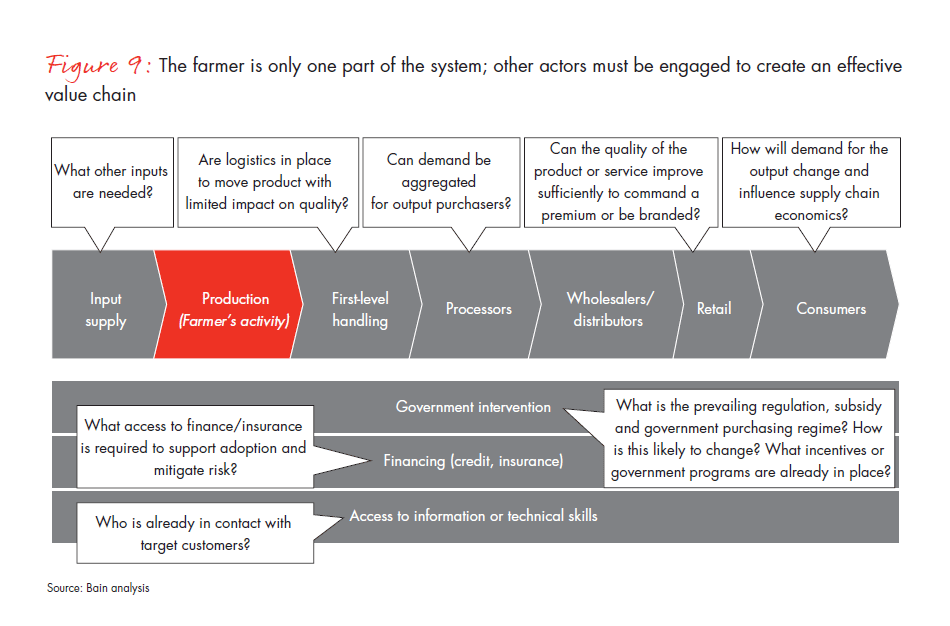
To maximize advantage to its customers, SV Agri pursued a range of partnerships along the value chain, from planting-material development to end processing. The company obtains high-yielding varieties of tubers from a large multinational company and works with the Indian government’s Central Potato Research Institute to multiply the tubers using aeroponic technology. It partners with local banks to provide financing for farmers by guaranteeing 10% of the loan amount. It also collaborates with Krüger & Salecker Maschinenbau GmbH & Company to manufacture processing equipment and provide support for processors.
The importance of understanding and influencing the value chain was also well understood by Acumen investee GADCO, an agri-food company that produces, processes and markets its Copa brand of long-grain rice in Ghana. Recognizing the need to improve yields and quality, based on the performance of its own 800-hectare nucleus farm, GADCO created a business model that would increase efficiency at its farm while also delivering increased earnings to smallholder farmers from whom GADCO purchases rice. The company intervenes directly in the value chain by distributing high-quality inputs to smallholder farmers on credit before the planting season, mitigating cash-flow constraints for the farmers at that time. The company purchases harvested rice, mills the rice and pays farmers a premium based on the quality of rice they are able to produce, which serves as an incentive for farmers to use better farming practices. Through its sponsorship of extension services, the firm provides farmers with information about farming methods and technical skills that enable them to realize higher yields.
For other segments of the value chain, GADCO has established partnerships to provide products and services it could not offer independently. Its partner, Syngenta, a Switzerland-based global agribusiness, provides seeds as well as inputs that protect crops. The World Bank has supported production by studying the financial and social impact of Copa Connect’s pilot initiative and provides advice on business model refinements. GADCO’s distribution partner, Ghana-based Finatrade Group, is responsible for the sales and marketing of Copa products.
Through these efforts across the value chain, GADCO and its partners have achieved significant impact. The yield of smallholder farms receiving support from GADCO is nearly twice the average for Ghanaian farms with irrigation (5.3 vs. 2.7 tons per hectare). Estimated net income per season for farmers participating in Copa Connect trials has increased fourfold, to approximately $1,900 (see Figure 10).
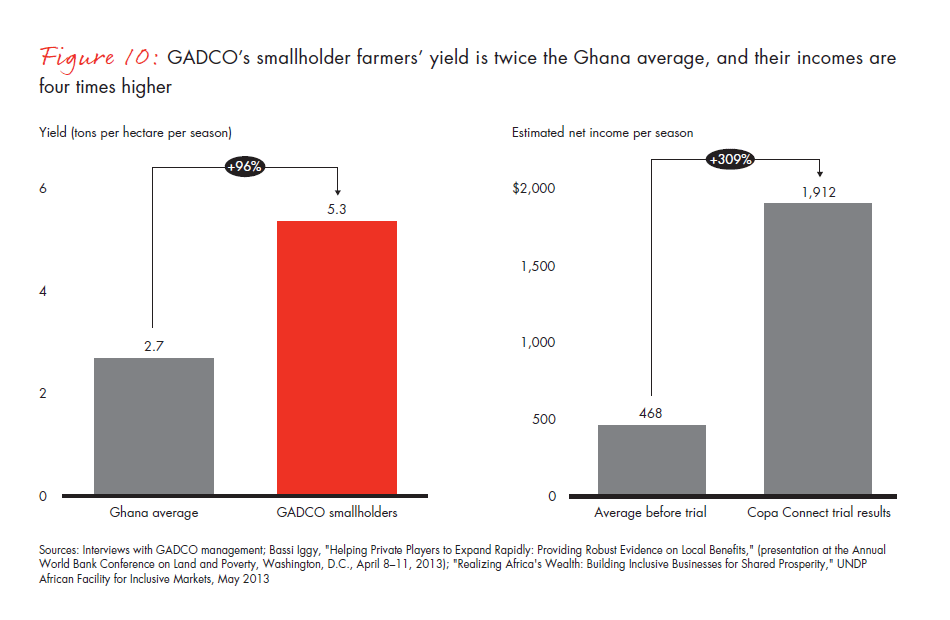
Put risk-mitigating structures in place to encourage initial adoption. Diseases or weather can wipe out a harvest or a herd of cattle. Pioneer firms can struggle to gain initial customer traction if they do not put in place risk-mitigation structures such as insurance3 or guaranteed incomes to overcome concerns that a new product or service may not perform as expected or may succumb to a natural disaster. Juhudi Kilimo, for example, includes insurance with its loans to protect both farmers and itself from the inherent risks of livestock farming. All farmers financed by Juhudi Kilimo are required to purchase insurance from the Kenyan Cooperative Insurance Company, which provides coverage in the event of a cow’s death or illness. Farmers purchase the insurance, which costs 4% of the animal’s value, when they register for the loan.
GEWP took an even more direct approach in persuading farmers to try its microdrip irrigation product. When the company was working with farmers to set up demonstration plots of one-quarter acre each, company representatives would ask farmers how much money they expected to earn from the yield of that much land. Since the company representatives understood the value of the crops, as well as how drip irrigation would increase yields, the company offered to pay each farmer the amount the farmer had suggested (as long as it was a reasonable estimate), regardless of actual yields. This essentially guaranteed the farmer a minimum income for that plot of land, eliminating the risk of the initial adoption. The microdrip systems ended up working so well that GEWP never had to pay cash to a farmer for a failed crop.

Use “high-velocity” feedback to validate the advantage being created and refine the product or service and business model accordingly. Far from being a smooth, predictable path to building customer traction, the early days of a pioneer firm are often filled with failures and disappointments as the entrepreneur tries to validate the right customer proposition and business model. These continuous loops of trying, failing and learning are particularly relevant in the development of the product or service prototype. Rather than wait for a “big bang” rollout of the perfect product, pioneer firms should pilot a “minimum viable product”4 with actual customers and use those customers’ feedback to further refine their proposition.
GEWP refined its product design by gathering feedback from early adopters across dozens of villages in the initial district in Maharashtra, where it launched its operations. To stay in close contact with farmers and continually learn from pilots, the firm’s employees, including members of the senior team, visited each village five to seven times a month to assess progress and tackle problems. These visits led to multiple product iterations to address various issues that farmers were facing, like burst pipes or clogged holes in the pipe. The firm also gave farmers prepaid postcards addressed to its managing director so that they could provide direct feedback. Similarly, as we saw in the earlier SV Agri example, customer feedback was pivotal in informing the company’s decision to modify its customer proposition and business model. SV Agri’s leadership realized it had to provide high-quality planting materials in addition to purchasing output at guaranteed minimum prices.
Advantage: Key questions to ask
- Do you understand the specific need your company is addressing from the farmer’s point of view?
- Do smallholder farmers sufficiently understand how your product or service will increase their income?
- What alternative solutions already exist that your target farmers are not using? Why not?
- Which gaps or constraints across the value chain can you address directly and which will require the support of partners?
- Do smallholder farmers have access to the complementary products necessary to gain the full advantage of your product?
- Do you have a clear process in place for observing your innovation in action with early adopters and for using the feedback to refine your proposition?
- How will exogenous factors (price shocks or environmental changes) affect the advantage provided?
- How much and what kind of risk mitigation is required for the earliest adopters?
Affordability
Affordability is closely related to advantage, given that the two factors combine to shape a farmer’s perception of a product or service’s value. In designing for affordability, pioneer firms must address two fundamental constraints faced by the smallholder farmer: low purchasing power and uneven cash flows. Nearly as important as the absolute price of a product are the size and timing of a cash outlay required and the time it takes to reap a benefit. A product or service with short payback periods (over just one or two crop cycles) is more attractive and seen as more affordable to a smallholder farmer.
Design to optimize unit economics. To maximize affordability for customers while building a foundation for financial sustainability, pioneer firms must design their product in a way that optimizes profitability on a per unit basis. GEWP did just this for its microdrip irrigation product (see Figure 11). GEWP began this process by examining its cost structure and realized that lateral pipes accounted for 65% of the cost of an irrigation system. To reduce manufacturing costs, the firm designed the pipes with thinner walls than traditional systems (125 to 250 microns compared with more than 1,000 microns). This enabled the firm to lower the pipes’ costs by 35% while maintaining the system’s effectiveness.
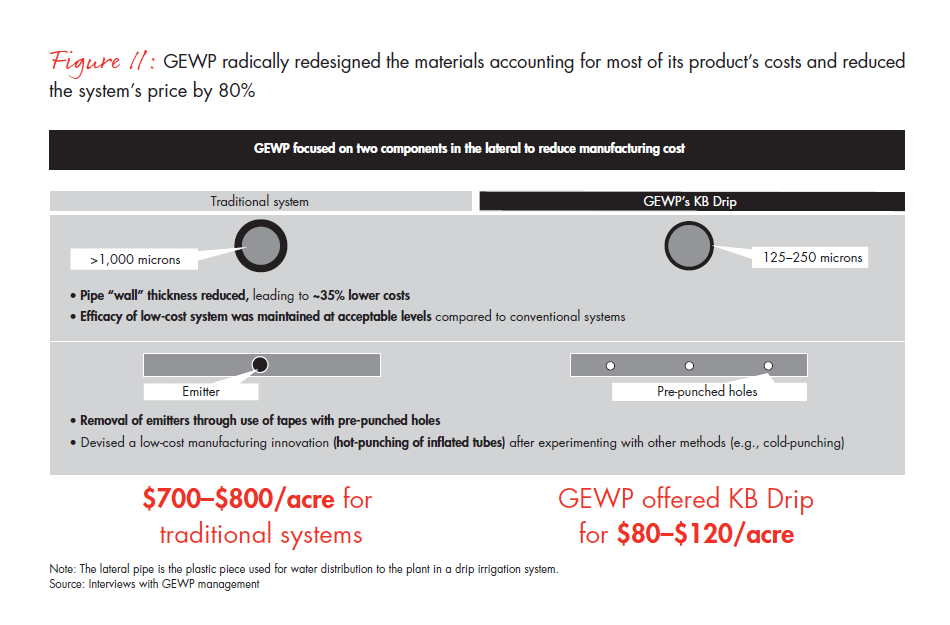
It was able to further reduce costs by replacing plastic emitters with tapes with pre-punched holes. The firm also devised a low-cost manufacturing innovation to create the holes by hot-punching inflated tubes. By reducing its raw material costs through these design changes, GEWP was able to offer its microdrip system for less than $120 per acre (compared with $700 to $800 per acre for traditional systems) while still receiving a margin of nearly $20 per unit. The lower costs have not translated into less durability: Many farmers have been using the systems for up to seven years.
It is worth noting that pioneer firms can take years of product or service design experimentation to reach positive unit economics. Even when the production costs of goods are minimized, achieving profitability can still be enormously difficult due to the additional expense of the marketing, delivery and support required to serve such a challenging customer segment. Across our case studies, companies had all wrestled with sustained periods of unprofitable growth. Many continue to struggle to find a path to profitability today. However, although we acknowledge the profitability challenges faced by pioneer firms, we believe that a viable path to longer-term financial sustainability must begin with a structurally profitable product or service.
Design to facilitate customers’ incremental purchase. Given smallholder farmers’ limited purchasing power, it is imperative for firms to design products and services that are better suited to small plots and small initial investments. As mentioned, traditional drip irrigation systems were designed for larger farms and were not affordable to smallholder farmers. GEWP’s innovation was to miniaturize and modularize the system to allow for easy testing and incremental additions on smallholder plots. GEWP systems can be used on a small section of a field, as small as one-quarter of an acre; once that system is set up, adding to it incrementally is relatively easy. A new GEWP system requires installation of a main valve, a screen filter and a main line originating from a water source—typically a bore well (see Figure 12). The farmer lays out an initial set of lateral pipes (plastic pipes used in the last section of water distribution). The only additional work required if a farmer wants to add to the system is to extend the sub-main line. Not only did the GEWP system as a whole cost considerably less than other systems available at the time, the system was optimized for trialing; benefits from a small initial purchase could be observed and the system can be easily extended to more of the farmer’s land. All of these elements together have made GEWP’s innovation affordable and accessible to a previously unserved farmer segment.
A GEWP system in place in Maharashtra, India
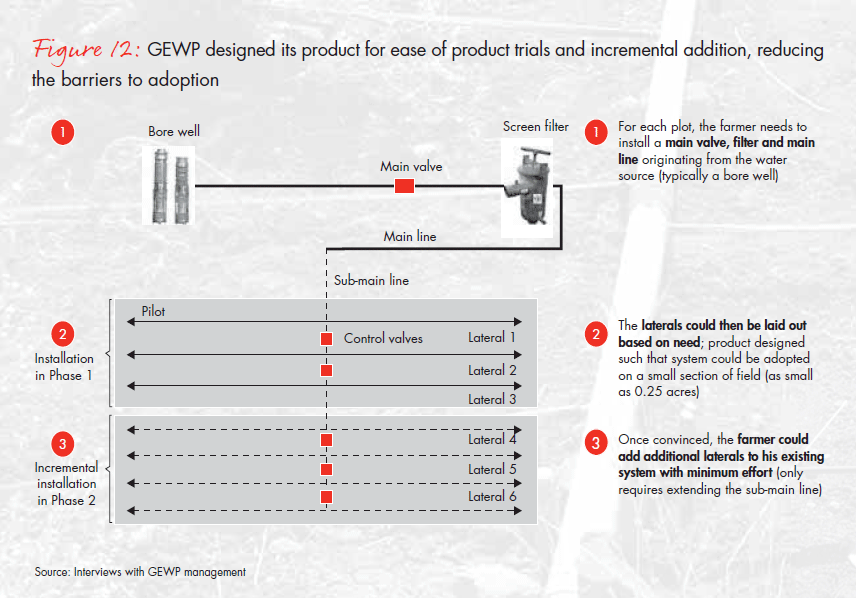
Understand cash-flow cycles and timing and align financing options. As discussed in Chapter 2, farmers’ income and cash flow can be irregular and the optimal time for them to make purchases is dictated by seasons and harvesting cycles. This makes it hard for farmers to save or spend large sums required for upfront payments for new products or services. Unconventional means of financing and risk sharing are often required so that cash flow constraints do not impede adoption. For example, although OAF provides inputs to farmers at a higher price than they would pay in local markets (about $80 per package vs. $70, when inputs are purchased separately from agrovets),5 it offers a flexible repayment plan and timely access to inputs. As one farmer explained, “I am able to pay back the loan after my harvest over a longer period. This flexibility is important given there are many other needs I must also meet and many that can be unexpected.” This sentiment was widely shared among the many OAF farmers we interviewed.
Other research has shown that the benefits of offering financing directly may outweigh the significant complications. For example, a recent Hystra report argued that “in addition to reducing the risk both for customers and operators, in-house financing can be a profit-making activity that has been seen to increase returns on sales by 3% to 15%.”6 In practice, we have observed mixed results when firms try to take on in-house financing for their customers: Although these activities can generate profits and drive affordability, they can also create significant tensions within the firm that can prove difficult to manage. Whether firms continue to experiment with direct provisioning of credit or instead choose to partner with banks or microfinance institutions (MFIs), they should actively consider credit extension to serve this target market.7
Harness volumes and increase operating model efficiency to drive down unit cost/price. The virtuous cycle of broad adoption allowing for greater production volumes, which in turn leads to lower prices and then to yet more adoption, is a well-accepted tenet of management thinking. The need to reduce unit cost is especially important over time for the pioneer firm as lower-cost competitors start entering the market. As we will illustrate in the next chapter, “Repeatable Models,” achieving this “experience curve effect” can be less straightforward in the context of developing-market agriculture, given the challenge of consolidating volumes across a wide geographic area. Specifically, we will illustrate the challenges that GEWP faced and what other firms can learn from its experience.
The imperative of driving down unit cost through greater operational efficiency is equally relevant for service companies. For example, Juhudi Kilimo sought to improve the branch profitability of its microfinance business after experiencing inefficient and unprofitable operations during its early, grant-funding days. Based on research from other MFIs and agricultural lenders, the company set new targets for critical operating metrics. It then adapted business processes to meet the higher productivity (from 120 to 250 clients per officer) and repayment ratio targets (from 87% to 94%). This new business model has enabled Juhudi Kilimo to achieve profitability at the branch level over time. A single branch with a $400,000 loan portfolio now earns profits of more than $10,000 on income of approximately $126,000.
Affordability: Key questions to ask
- What are the key cost drivers for your product or service for the individual farmer?
- How can you reduce the cost through redesign of your product or service proposition while delivering the requisite functionality for your customers?
- To what extent can the timing of the purchase of the product or service be managed to enhance its affordability?
- Given the income levels and cash-flow profiles of your target customers, what financing options might you need to provide?
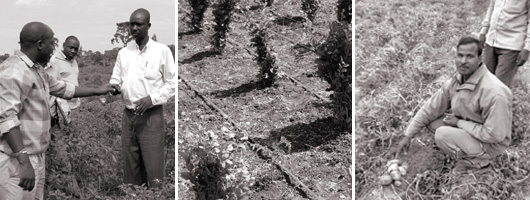
Access
The importance of last-mile access for farmers in rural areas has been written about extensively. Given the need for geographically dispersed smallholder farmers to access physical inputs at the exact right time in the crop cycle, farmers’ proximity to an agricultural product, like a bag of seed or fertilizer or a mechanized implement, is even more important than it is for other low-income-focused products, such as solar lights or clean cook stoves, which can be more easily transported. Some products may also require more continuous after-sales service, in which case the firm’s continued presence in the community will be a large part of the value proposition.
However, pioneer firms should consider existing retail options and actual buying behaviors and mobility constraints before defaulting to a last-mile distribution model. Once again, a fine-grained understanding of farmers’ needs in the context of a specific innovation is essential.
Plan production and distribution in advance to ensure access in the right quantities at the right time. OAF considers access such a critical factor that it insists on delivering its inputs to farmers on the day they need them and within walking distance—generally less than five kilometers. OAF’s director of operations in Kenya put it this way: “For 10 months of the year, we are a school and a bank; the other two months, we are a logistics company.” In Kenya, OAF runs a tightly managed logistics operation to ensure it can, in eight weeks, deliver inputs to more than 80,000 farmers at 530 sites located throughout 16 districts. Achieving this level of effective access requires careful advanced planning and rigorous management of production, sales and distribution. In fact, dates for delivery are set one year in advance, because sowing seeds even a few days late may reduce yields.
The ability to master a distribution system this complex, whether the system is company-owned or relies on partners, is a crucial factor in success as companies grow to serve more, and more dispersed, customers. Timing is generally very important but can be critical for some products. For example, artificial insemination delayed by a few days might mean needing to wait another month for the animal to be in heat again. For companies operating in these industries, getting the distribution timing right is a must.
SV Agri offers a different example of how pioneer firms can build an effective distribution network. The company invested heavily in a network of franchisees to distribute its products and services to potato farmers. The firm looks for individuals committed to SV Agri’s business and impact model who have deep social connections in their village. It provides franchisees with annual training in agronomic and business practices. It also supports them throughout their business cycle by supplying inputs to their shops; by providing equipment and expertise required for soil testing, pest management and potato quality testing; and by procuring potatoes at harvest time.
Carefully consider what kind of distribution network is required, given farmers’ purchasing habits. Retail outlets can be effective for providing access to certain types of products and services. For example, Kenyan farmers travel to Sidai’s Livestock Service Centers, even in remote locations, to buy livestock and crop inputs, such as vaccines, feeds and seeds. The firm has designed a modern retail format that offers open access to customers, as well as the opportunity to discuss products with well-informed sales staff. Depending on its product or service, a firm can also piggyback onto an existing distribution network rather than create a new one. For example, GEWP found that many of its customers owned motorcycles and regularly traveled to the nearest town or city to purchase agricultural inputs. Instead of establishing its own outlets or logistics capability to sell KB Drip, the firm created a network of third-party dealers in these locations that were already selling related products, like pipes, pumps and ancillary electrical equipment.
Access: Key questions to ask
- How and where do your target customers currently purchase agricultural products and services?
- What is the condition of the physical infrastructure in the areas you are serving?
- Do your target customers have access to means of transportation and to what extent are they willing to travel?
- Are there existing retail outlets that could reliably and effectively sell your product (and provide both the required information and physical distribution)?
- How would selling through a retail outlet affect your economics and your competitiveness from both the retailer and end customer perspective?
- To what extent does distribution timing affect the advantages that your product provides?
Farmer profile: Rangnath

An early adopter of GEWP’s microdrip irrigation (KB Drip)
Rangnath* owns several acres of land in Maharashtra, India. He grows mostly pomegranates, tomatoes and chilies. Though his sons help him run the farm, he is the final decision maker on the adoption of new agricultural products and services.
“I heard about KB Drip in 2007 from company officials who drove to my village,” says Rangnath. “They told me I could save water at a fraction of the cost of the more expensive systems I’d seen on larger farms,” he says. Given his limited purchasing power, he had instead run a generator that pumped water to flood his fields.
He and his sons decided to buy KB Drip because of the severe drought that struck the region. Initially skeptical about the product’s benefits, they agreed to let GEWP install drip irrigation on a small plot where they grew tomatoes. After two months, they saw how many more tomatoes grew per vine, how a relatively small amount of water could cover a large area, and how weeds were reduced because the water dripped only onto the tomato plants.
Rangnath purchased KB Drip for only a quarter of his land, paying for it from the family’s savings because he could not take out a loan. He has since invested more in microdrip irrigation and is now using it on nearly half his land (on the other half, he wants the flexibility to grow dense crops, such as wheat or corn, for which drip irrigation is not appropriate). “Using KB Drip has increased my yield considerably and allowed me to continue farming despite the drought. I have doubled my income and built another house,” he says proudly.
* Full name and select personal details have been disguised
NEXT · CHAPTER 4 · Repeatable Models: The key to achieving "good scale"
The Four A’s, rationality and emotion
As the authors of Scarcity: Why Having Too Little Means So Much have pointed out, being poor greatly affects decision making and, most often, impairs it. The significance of the trade-offs being made and the limited amount of resources with which to make them often lead to decisions that keep the poor in a “scarcity trap.”8 The Four A’s framework is built on the assumption that if farmers are able to see the potential advantages (increased yields and wealth) that could be achieved by adopting a product, they would do so. Although this is true for most farmers, particularly those who see their land as a productive asset and their labor as a means to generate more income, we acknowledge that for the poorest farmers or those confronting the challenges and trade-offs required when, for example, providing for a sick family member or sending a child to a better school, rational decision making is not so straightforward.
In addition, there is another A that influences adoption by customers everywhere: aspiration. Often, purchase decisions are based on factors other than those stated and then rationalized after the fact. The emotional intensity a customer may feel about seeds or irrigation equipment can seem exaggerated, but these products also symbolize social status, and he will purchase them in the hope that they will improve his family’s life—enable him to build a new room, buy a motorcycle or allow his child to move to the city. Thus, beyond convincing customers of the compelling advantages of a product’s purely functional utility, appealing to customers’ aspirations is a key aspect of spurring adoption.
A checklist: The Four A’s
Getting the Four A’s right is paramount for creating a foundation for adoption. Below is a set of key questions to help entrepreneurs systematically ensure that each of the Four A’s is in place for their farmer customers.
Awareness
- To what extent do farmers know about your product or service category (e.g., microfinance, microdrip irrigation) and about your specific company offering?
- What characteristics (e.g., demographic, behavioral, environmental) should guide your sales team’s early-adopter customer targeting efforts?
- Is the accompanying information (e.g., planting techniques, installation) critical to your product’s effective use always shared and well understood?
- What are the most effective communication channels to reach your target customers?
- How will you identify the “promoters” among your early-adopter customers and empower them to tell other prospective customers about your product or service?
Advantage
- Have you understood the specific need your company is addressing from the farmer’s point of view?
- Do smallholder farmers sufficiently understand how your product or service will increase their income?
- What alternative solutions exist today that your target farmers are not using? Why not?
- Which gaps or constraints across the value chain can you address directly and which will require the support of partners?
- Do you have a clear process in place to observe your innovation in action with early adopters and use the feedback to refine your proposition?
- How will exogenous factors (price shocks or environmental changes) affect the advantage provided?
- How much and what kind of risk mitigation is required for the earliest adopters?
Affordability
- What are the key cost drivers for your product or service on an individual farmer level?
- How can you reduce the cost through redesign of your product or service proposition while delivering the requisite functionality for your customers?
- To what extent can the timing of the purchase of the product or service be managed to enhance its affordability?
- Given the income levels and cash-flow profiles of your target customers, what financing options might you need to provide?
Access
- How and where do your target customers currently purchase agricultural products and services?
- What is the condition of the physical infrastructure in the areas you are serving?
- To what extent are your target customers willing to travel and have access to means of transportation?
- Are there existing retail outlets that could reliably and effectively sell your product (providing both the required information and physical distribution)?
- How would selling through a retail outlet affect your economics and your competitiveness from both the retailer and end-customer perspectives?
- To what extent is the advantage provided by your product affected by distribution timing?
The Four A’s from blueprint to scale
From Blueprint to Scale: The Case for Philanthropy in Impact Investing, a previous report by Acumen and Monitor Inclusive Markets, provides a framework for the four stages of a pioneer firm9:
Blueprint. As a first step, firms need to create a detailed design for their future business. This entails selecting and developing a product or service to serve the target community of farmers, as well as a business model for bringing it to the market.
Validate. Next, the firm needs to test and refine the product or service, as well as the business model. This includes identifying which farmers could be the initial adopters and testing the product or service with them to generate a “demonstration effect” that will persuade other farmers to adopt it.
Prepare. After validating their innovations, firms need to ensure that relationships, channels and systems are in place for achieving scale. These include partnerships, distribution channels and approaches for promoting awareness.
Scale. To enable a rollout that reaches a large number of farmers, firms must reduce costs, promote advocacy by existing customers and sustain their brand’s presence in the market.
To help firms apply the Four A’s, we mapped them against these four stages of a pioneer firm’s development. Although the Four A’s are relevant at all stages of a company’s growth, advantage and affordability will be the primary focus early on, when the firm is determining a product’s suitability for the market. Access and awareness will become increasingly important later when the firm focuses on achieving scale.
More specifically, in the Blueprint and Validate stages, pioneer firms need to focus on being able to deliver a core product that creates advantage at an affordable price with a trial-size cash outlay. High-velocity feedback loops drive improvements in the product as the company adjusts to customer preferences. And it is important that the firm, even at this early stage, strike the right balance between affordability and a pricing model that has a view toward the long-term financial viability of the enterprise.
As the firm progresses to the Prepare and Scale stages, generating awareness by disseminating the core marketing message and customer success stories is at the core of driving further adoption, along with expanding access by using a strong distribution model that allows for sustained penetration of the company’s core market.
From the outside, these four steps might seem intuitive enough. However, what is less apparent is that the step from Prepare to Scale can often feel more like a chasm for the pioneer firm. Within the context of smallholder agriculture in developing countries, adoption at scale needs to occur at multiple levels: villages, regions and countries. Differences within and across these markets are among the most significant barriers to making the adjustments that growth requires. In the next chapter, we explore how firms can use Repeatable Models to achieve “good scale” and drive sustained, widespread adoption.
1 Everett M. Rogers, Diffusion of Innovations, 5th ed., New York: Free Press, 2003.
2 See Net Promoter SystemSM, a Bain & Company website, http://www.netpromotersystem.com/ for more information. Our primary research with farmers also made this clear, as more than 65% of early adopters heard about a product or service from a company official. This dropped to only 28% for late adopters, for whom friends and relatives make up over 55% of the first information providers.
3 Potentially bundled with other products or ways of mitigating risk, given the relative complexity of a product like insurance.
4 Steve Blank, “Why the Lean Start-up Changes Everything,” Harvard Business Review, May 2013.
5 OAF also provides the farmer with training and crop insurance as part of the package, which increases the overall price.
6 Hystra, Marketing Innovative Devices for the Base of the Pyramid, Paris: Hystra, 2013.
7 It is worth noting that almost all of the GEWP customers we interviewed in India purchased KB Drip from their family savings. We can’t help but wonder how greater access to financing in this case might have facilitated the faster and broader adoption of microdrip irrigation.
8 Sendhil Mullainathan and Eldar Shafir, Scarcity: Why Having Too Little Means So Much, New York: Macmillan, 2013.
9 See Harvey Koh, Ashish Karamchandani and Robert Katz, Blueprint to Scale: The Case for Philanthropy in Impact Investing, Mumbai: Monitor Inclusive Markets/Acumen, 2012.




